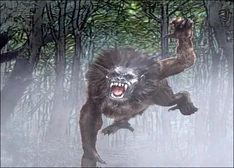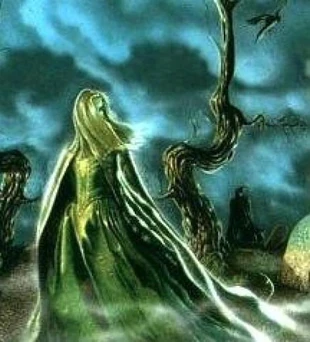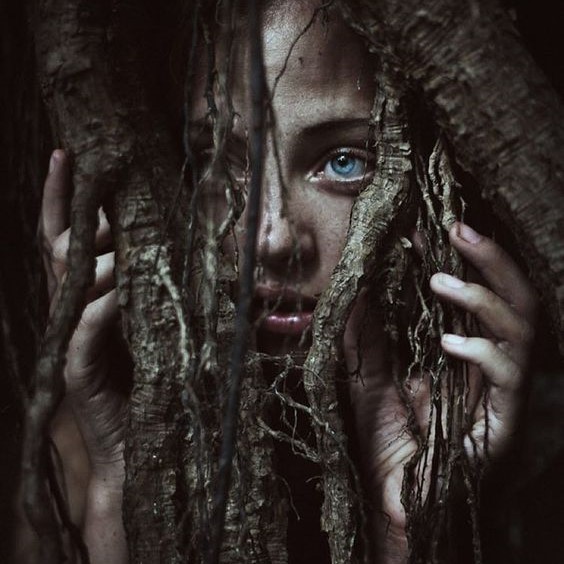-----------------------------------------
(
Next week's post will be the Succubus, Happy early Valentines Day................
-----------------------------------
Ahri League of Legends by ASTELTAINN
A
kumiho (
gumiho)
is a type of fox spirit in Korean mythology
=======================================
The Kumiho like the Japanese Kitsune is a supernatural fox creature ..
Fox spirits are popular east Asian figures Korea, Japan and China all have ancient myths and folklore regarding them.
According to legend a fox that manages to live a thousand years turns into a kumiho, like other fox legend's the kumiho can transform at will usually taking on a female form they will then set out to seduce men, and according to some versions on the myth eat there heart or liver.
===============
Fox spirits are in a way similar to the Succubus in that they take the form of seductive young woman....
===================
Shin Min-ah plays a fox girl in the South Korean comedy romance My Girlfriend is a Gumiho ..
===================
The encyclopedic
Compendium of Korean Oral Literature contains a lot of story's regarding the gumiho..
=========================
Even though the Gumiho has the power to transform into a
human (Most often a beautiful woman). They
still something retain one or more fox-like features.
For example in her human form she may still have , a fox like face or pointed ears
hidden under her hair, or maybe even nine fox tails that only become visible when her wedding dress is removed. Though able to change between human and
fox forms, a Kumiho is very cautions and guards her true identity.
It is believed that a kumiho can transform into the identical likeness of a bride at a wedding and is only discovered when her clothes are removed on the honeymoon and her fox tail is reveled.
Bakh Mun-su and the Kumiho (박문수와 구미호) records an encounter that Pak Munsu has with a girl, living alone in the woods, that has a fox-like appearance. In
The Maiden who Discovered a Kumiho through a Chinese Poem (한시로 구미호를 알아낸 처녀), the kumiho is ultimately revealed when a hunting dog catches the scent of a fox and attacks the girl. Although they have the ability to change physical forms, a kumiho dose not change there true nature.
However it is believed that kumiho how abstains from killing and eating humans
for a thousand days, can become human.
=========================
Nine tailed fox myths and legends seem to have Originated in China centuries ago and later being introduced to introduced to both Korean and Japanese mythology.
The Korean Kumiho / Gumiho shares many similarities to the Chinese Huli Jing and the Japanese Kitsune an old Chinese text, claims a fox with nine tails lives in an area
called Qingqiu (靑丘).
As the kumiho and other versions of the nine-tailed
fox myths originated from China, they all have a similar
concept.
The all describe fox spirits as being the result of extreme longevity
or the accumulation of energy.
Usually foxes who have lived for at least thousand years, will gain the power of shape-shifting.
However there is still some differences between the legends , while the Chinese
huli jing and the Japanese
kitsune are usually said to have a more ambiguous moral compasses, possibly good or evil, the
kumiho
is almost always treated as a malevolent figure who feasts on human
energy and sometimes there flesh.
Ahri League of Legends found on Wallpaper HD
======
It is unclear at which point in time Koreans began viewing the
kumiho as a evil creature, since many ancient texts from China mention a more benevolent
kumiho helping humans (and even make mentions of bad humans tricking kind but naïve
kumiho).
In later text,
kumiho
were often depicted as bloodthirsty half-fox, half-human creatures that
wandered cemeteries at night, digging human hearts out from graves simelar to Ghoules.
---------------
The
fairy tale The Fox Sister A fox spirit preying on a family for their livers.
However, according to Gyuwon Sahwa,
kumiho is described as an auspicious fox spirit with a book in its
mouth. Considering the text is thought to be written in 1675, some
speculate that the modern violent image of kumiho is influenced during
the Japanese occupation in Korea.
Nevertheless, foxes often contained a
negative image during the Koryo Dynasty (Shin Don) was described as an old fox spirit due to his love for women and drinks
despite his being a buddhist monk), suggesting two different views
could have co-existed in ancient Korea.
===============
The Gyuwon Sahwa was written in 1675, and describes ancient Korean history including the creation of the universe.
Today, its principal value is generally seen in its role as a historical
story reflecting the consciousness of the period, rather than as a
historical record. Similar contents are also found in Hwandan Gogi, which is generally believed to have been influenced by the
Gyuwon Sahwa
The Gyuwon Sahwa is now kept at the National Library or Korea.
---------------------------------
The most distinctive feature that separates the kumiho from its
two counterparts is the
existence of a 'yeowoo guseul' (여우구슬, literally meaning fox marble/bead)
which is said to consist of knowledge.
According to Korean mythology,
the yeowoo guseul provides power to the kumiho and knowledge (and
intelligence) to people if they can steal and swallow one.
The kumiho
can absorb humans' energy with it. The method of absorbing energy with
the "yeowoo guseul" resembles a "deep kiss" (a kiss using the tongue).
The kumiho sends the yeowoo guseul into people's mouths and then retakes
it with their tongues. If that person swallows the yeowoo guseul,
however, and then observes "sky, land, and people", each observation
gives the observer preternatural knowledge. But the person fails to
watch the "sky" in most tales, so they get a special ability but not the
most important one.
.................................................
Just like Vampire's, Witches and Werewolf story's in Western folklore, there are always going to by slightly different variations on the myth depending on
the person recounting them.
In one older version of this
myth, says that with enough will, a
kumiho could ascend from its yokai form and become permanently human there by lose its evil characteristics.
Explanations of how this could be possible vary, but sometimes include
aspects such as refraining from killing or tasting meat for a thousand
days, or obtaining a cintamani and making sure that the Yeoiju saw the full moon at least every month during the ordeal. Unlike Yeoiju-wielding dragon ,
kumiho were not believed to be capable of optioning omnipotence or creation at will, since they were lesser creatures.
-------------
9 Tails fox's power's and abilitys----
Fox spirits can create and control Fox Fire lightning ......
 Aside from heightened intelligent and extreme
longevity, 9 tailed fox's are said to have many different ability's and
supernatural powers
Include possession, generating fire or lightning, and manifesting in the dreams of others at will.
Aside from heightened intelligent and extreme
longevity, 9 tailed fox's are said to have many different ability's and
supernatural powers
Include possession, generating fire or lightning, and manifesting in the dreams of others at will.



















































